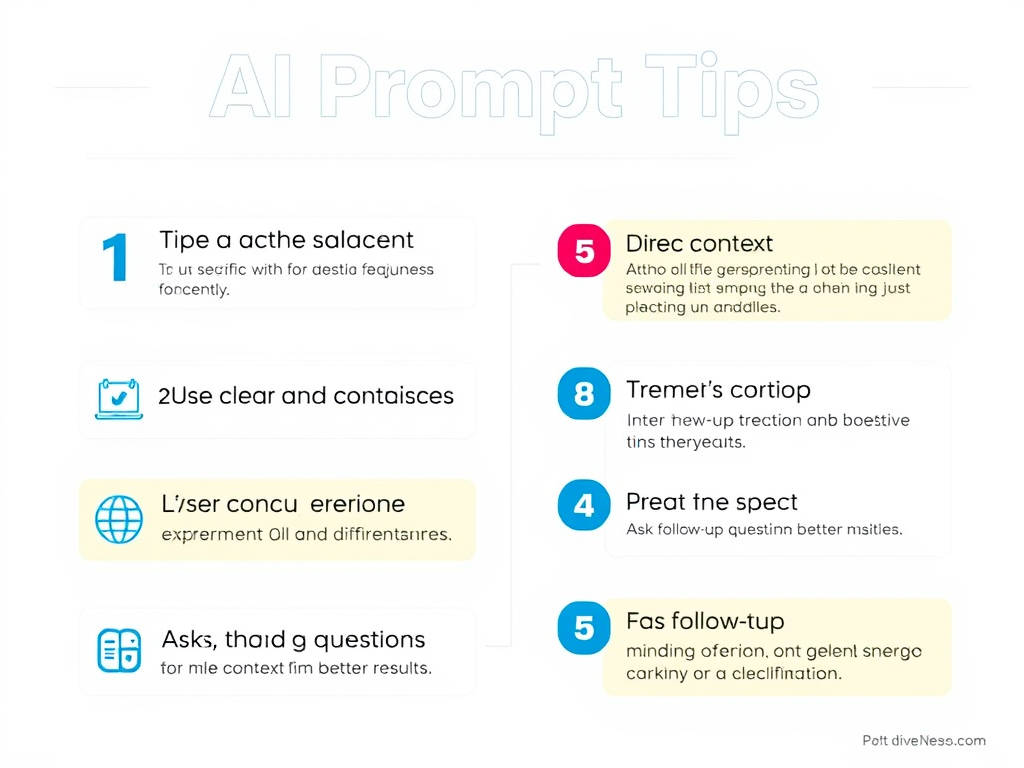Alright. So, we’ve got these things now. These AIs. They can write stuff, make pictures, crunch numbers, and generally do some mind-boggling things. But to get them to do what we want? Ah, there’s the rub. It’s not like talking to another person. It’s a whole new dance.
You know that feeling? When you’re trying to explain something slightly complicated to someone who just doesn’t quite get the context? Like explaining an inside joke to a stranger, or describing a dream out loud, and realizing the words just aren’t capturing it? Talking to AI can feel a bit like that at first.
They call them “prompts.” Sounds technical, doesn’t it? But really, it’s just… us trying to find the magic words. The specific combination of phrases that unlocks the potential sitting on the other side of the screen.
Here are a few things I’ve learned, not from a manual, but from just… messing around. From trial and error, from sighs of frustration, and from little bursts of “Aha!” when it finally clicks.
1. It’s Like Teaching a Brilliant, Utterly Literal Child.
Forget subtlety. Forget nuance, at least initially. If you want a story about a cat who solves crimes, you don’t just say “cat detective story.” You gotta spell it out: “Write a short story about a ginger cat named Whiskers who wears a tiny trench coat and uses his incredible sense of smell to solve mysteries in a quaint English village. Make him grumpy but lovable.”
The more detail you give, the less it has to guess. And believe me, when AI guesses, it can get weird. It doesn’t have your life experience, your cultural baggage, your feeling for how things usually go. You have to build the world for it, one brick at a time.
2. Think Like a Director, Not Just a Requestor.
You’re not just asking for a thing; you’re setting a scene. Tell it who it is (the voice it should use – a wise old wizard? a chirpy teenager? a newspaper headline?), what the goal is, how it should deliver it (as a poem? a list? a conversation?), and even the mood (funny, serious, mysterious, hopeful?).
It’s like handing it a script and saying, “Okay, you’re playing the part of the grumpy librarian, and your goal is to tell me about Renaissance art in a way that makes me slightly afraid to ask follow-up questions.” Giving it a role and a context changes everything.
3. Don’t Be Afraid to Be Picky (and Patient).
The first answer you get probably won’t be perfect. That’s okay! This isn’t a one-shot deal. Think of it as a conversation where you guide it. “Okay, that was good, but can you make the cat more grumpy?” “Can you add a quirky sidekick, maybe a talking squirrel?” “This list is helpful, but can you put it in bullet points and explain each item in one sentence?”
It’s a back-and-forth. You provide feedback, it adjusts. You refine your request, it tries again. It takes a little patience, and the willingness to say, “Nope, try again,” until you get closer to what’s in your head. It’s less like ordering fast food and more like collaborating with someone who needs constant, clear direction.
4. Sometimes, You Gotta Give it an Example.
You know how sometimes it’s easier to just show someone what you mean? AI is often like that. If you want text in a very specific style, or a picture that looks like a certain kind of art, sometimes the best way is to say, “Write something like this: [Paste your example text here].” Or “Create an image in the style of [mention artist or style].”
It gives the AI something concrete to learn from, a pattern to follow that’s clearer than just your description. It’s like showing it a picture of the haircut you want instead of just trying to describe it.
5. Embrace the Weirdness (and Learn From It).
AI will sometimes give you nonsensical garbage. It will combine ideas in ways that make no sense to a human. It might confidently state things that are factually incorrect (they call that “hallucinating”). Don’t get frustrated. Ask yourself why it might have gone down that path. Did I ask an ambiguous question? Did I use a word with multiple meanings? Did I not provide enough context?
Understanding why it failed can teach you how to ask better questions next time. It’s like learning a foreign language – you’ll make mistakes, sound ridiculous sometimes, but each error is a lesson in how the language (or in this case, the algorithm) works.
At the end of the day, figuring out how to “prompt” AI isn’t about mastering a complex command line. It’s about learning a new form of communication. It’s about being clear, being creative in your instructions, being patient, and being willing to experiment. It’s about the very human process of trying to connect with something fundamentally different from ourselves, and finding the words that bridge the gap. It’s less science, more… conversational art. And honestly, figuring out that art is half the fun.



